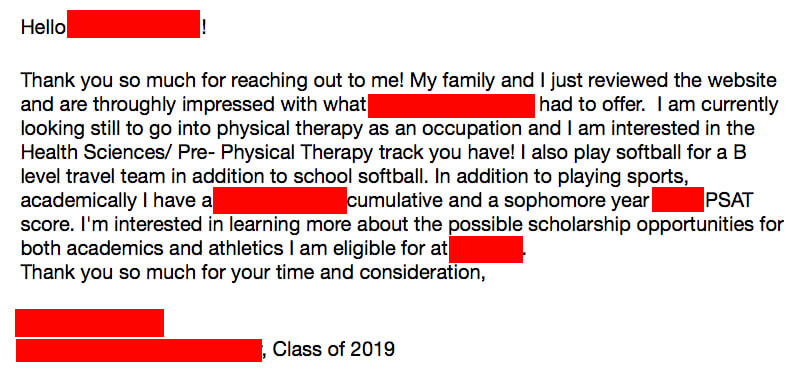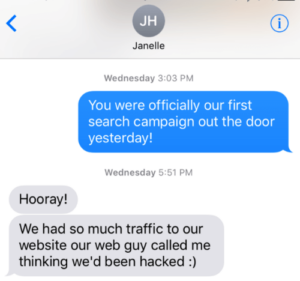Last week was a busy one here at Waybetter as we launched a whole bunch of undergraduate search campaigns for our clients.
While generating conversations with millions of prospective students is genuinely exciting and rewarding, it’s also a gargantuan undertaking that’s got us feeling pretty exhausted. But before we commence our recovery, we thought we’d share some of the best practices that have helped us execute successful search campaigns for the colleges and universities in the Waybetter family over the last decade.
If you’re managing search in house, here’s where we’d start:
1) Have a game plan.
As with just about everything in higher ed marketing (and, you know, life in general) you’ll enjoy more success and endure less anxiety if you set realistic goals and devise an actionable plan for reaching them. So…

- Be clear about what you want to accomplish.
Do you need to enroll a certain number of students? Do you need to enroll a student body with certain attributes? (Higher test scores or GPAs? More diverse economically/racially/geographically? Fewer athletes?) Do you need to bring in a certain amount of net revenue? - Set the goal(s) and work backward.
Then, based on your goal (and using historical precedent as a benchmark), get to work deciding what your data buy should look like. What criteria are you buying more or less of? From which cities, counties, states, countries? What score ranges? How many names are you buying? - Use historic yield estimates
(prospect to inquiry, inquiry to applicant, applicant to admitted, admitted to enrolled) to inform your decisions. Remember: You gotta start with enough if you want to end up with enough.
Once your search campaign starts driving activity and generating inquiries, what then? Do you have a comm flow ready to go? What happens when a high school sophomore responds to your search campaign? Do you have a process in place for nurturing her interest over the next three years? It would be a shame to let a strong search strategy go to waste because you weren’t ready to capitalize on its success.
***One quick caveat with the whole planning thing: Your plan doesn’t have to be perfect! Don’t let analysis paralysis keep you from getting started. Just do your best and then hop to it. You can improve the plan next time (and the time after that).***
2) Search for sophomores.
Strange as it may seem, high school sophomores (and their parents) are seriously considering their college options. So do your best to get their attention—let them know who you are and how you can make a difference! If you’re lucky, you might be the first college to start a conversation with a prospect. Sure, your competitors will eventually crash the party, but being first can generate significant brain share and engender real loyalty.
Need convincing? Take a look at the this email that a sophomore PSAT taker sent to one of our clients last week. How cool is that?

And speaking of being first…
3) Launch your search on time.
This year, the College Board released data on January 3rd, which meant the Waybetter crew was hard at work over most of the holiday break planning our data buys and fine tuning all the moving parts of our search outreach. Sure, we could have delayed it a couple weeks and enjoyed a bit more time off, but we ardently believe in the importance of getting a student’s attention early (and first if possible).
It’s a huge competitive advantage—one you can get for free, if you’re prepared to launch as soon as the data is released.
4) Launch again (and again and again).
Unlike wine, data does not get better with age. So keep it fresh. When prospects who fit your profile become available, buy them and add them to your search outreach. Regardless of source (PSAT, SAT, ACT, NRCCUA, AP, etc.), it just makes good marketing sense to continually initiate conversations with people who, by every available indicator, are likely to be a good match for you. Don’t ignore them just because they took a test on a different Saturday.
5) Be personal, relevant, and real.
One of our guiding principles here at Waybetter is that marketing is a conversation—and for a conversation to be worth having, it should feel personal and be relevant to all involved.
That’s why we begin our clients’ search outreach by talking about what matters to prospective students. We can do this at the individual student level because the various technologies we employ allow us to create dynamic email and web environments that directly address these interests. They also allow us to learn even more about what matters to individual prospective students so we can further the conversation by responding (in real time) with relevant, engaging content.
Sure, it’s not a “real” conversation; but it’s a pretty good simulacrum of one using the best automation technology available. Even more to the point, a commitment to personalization and relevance enables our clients to quickly deliver their most compelling argument—their value proposition—for why a prospective student should consider them. If that argument isn’t convincing or isn’t what the prospective student wants, then both parties—the prospect and the college—can move on. And there’s absolutely no harm in that! After all, if you purchase 100,000 names, you’re going to lose a few on your way to building a first-year class of 600.
Whatever you do, treat prospective students like you’d want to be treated, and talk to them like you’d want to be talked to if you were about to start making one of the biggest decisions of your life.
Be personal. Be relevant. Be real.
6) Ignore the noise.
Alright, we said there’d only be five, but we’re throwing in a sixth for free in case you ever find yourself needlessly stressing about all the stuff you’re not doing or feel you don’t know enough about.
It’s become fashionable in certain higher ed marketing circles to proclaim the death of the traditional enrollment funnel. The folks who peddle this position (and who want your money, by the way) will try to tell you that prospective students no longer read email, that they’re savvy enough to find what they’re looking for without being marketed to, that regardless of what you do you’re just going to wind up with a bunch of stealth apps anyway, and that all you can do is try to reach them on (expensive!) platforms like Spotify and Snapchat and Instagram and by running pricey pay-per-click campaigns through Google and other digital ad platforms.
Well, to those folks, we’d simply say this: We sent a few million emails last week—and prospective students from all over the country opened them and read them and clicked on them, and we tracked them to our personalized web environments and all the way through to our clients’ websites. Want a little proof?

Here’s one of the best texts I’ve ever received in my professional life. It’s from Janelle Holmboe, VP of enrollment at Warren Wilson College. I texted her (like the huge enrollment marketing nerd that I am) to say that Warren Wilson was Waybetter’s first official search launch of 2017. Her reply said, “Hooray! We had so much traffic to our website our web guy called me thinking we’d been hacked :)” It made me feel really good about the work I do, and it made me feel even better about the way we do that work here at Waybetter.
So, should you do the other stuff? The Snapchat and Instagram and content marketing? Sure, if you have the money, why not? It can’t hurt! But if your goal is to sustainably build a class of a certain size or with certain attributes, you gotta ignore the noise. Trust us, you can’t go wrong by starting with a commitment to good marketing process, which yes, still includes a good ol’ fashioned filling of the funnel.
Want to talk about building sustainably bigger enrollments at your institution? Get in touch.
Joel Anderson is Waybetter’s VP of Marketing & Strategy. Higher ed is all he knows.
